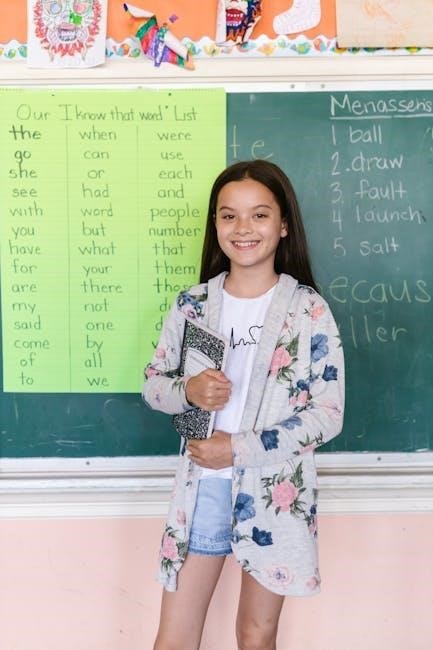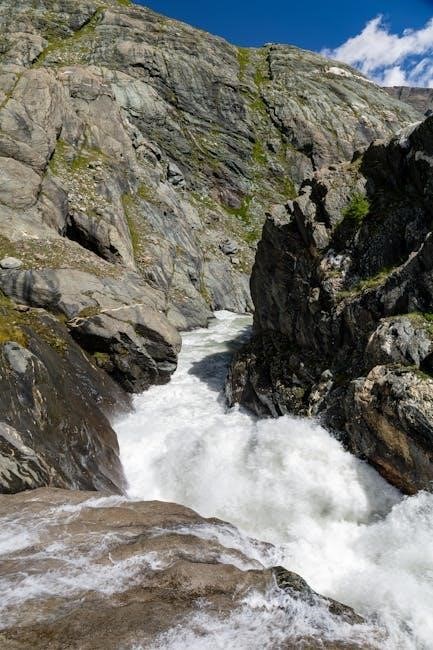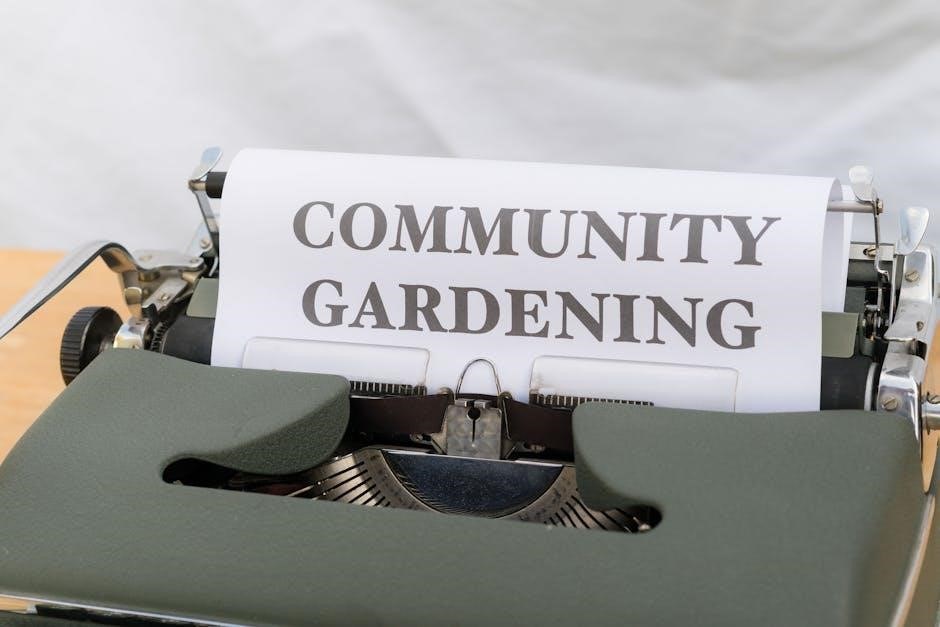Eco-literacy is the ability to understand and interact with natural systems, fostering awareness of human impacts on the environment. It promotes sustainable living and environmental stewardship through education.

Defining Eco-Literacy
Eco-literacy refers to the ability to understand and interpret the natural world, recognizing the interconnectedness of human and environmental systems. It involves knowledge of ecological principles, such as biodiversity, ecosystems, and sustainability.
This literacy enables individuals to critically analyze environmental challenges and contribute to solutions. It combines scientific understanding with practical skills to address real-world issues like climate change and resource management.
At its core, eco-literacy empowers people to make informed decisions that promote harmony between human communities and the natural world, fostering a deeper appreciation for the Earth’s systems and their role within them.
Importance of Eco-Literacy in Education
Eco-literacy is essential in education as it equips students with the knowledge and skills to address environmental challenges and promote sustainability. It fosters critical thinking and problem-solving abilities.
By integrating eco-literacy, educational systems prepare future generations to understand the interconnectedness of human and natural systems, encouraging responsible stewardship of the planet.
This educational approach not only enhances scientific understanding but also cultivates empathy and a sense of responsibility toward the environment, empowering students to contribute to a sustainable future.

Curriculum Components
Eco-literacy curricula include core subjects like science, social studies, and humanities, emphasizing sustainability, environmental stewardship, and interdisciplinary learning to foster holistic understanding and action.
Core Subjects: Science, Social Studies, and Humanities
Science, social studies, and humanities form the foundation of eco-literacy curricula, integrating environmental concepts into traditional subjects. Science focuses on ecosystems, biodiversity, and natural processes, while social studies explore human interactions with the environment and sustainability. Humanities emphasize ethical and cultural connections to nature, fostering critical thinking and empathy. These subjects are taught through interdisciplinary approaches, encouraging students to understand the interconnectedness of environmental, social, and economic systems. By embedding eco-literacy within core subjects, education systems equip students with the knowledge and skills to address global challenges like climate change and promote sustainable practices. This holistic approach ensures that students develop a deep understanding of their role within the natural world.
Integrating Eco-Literacy into K-12 Education
Integrating eco-literacy into K-12 education is essential for fostering environmental awareness and stewardship among students. By incorporating ecological concepts into curricula, schools can help students understand the interconnectedness of natural and human systems. Eco-literacy is introduced through hands-on activities, outdoor learning, and project-based approaches that align with science, social studies, and humanities. This integration encourages critical thinking, empathy, and active participation in sustainability efforts. Schools also collaborate with communities to provide real-world learning opportunities, such as environmental restoration projects or energy conservation initiatives. Early exposure to eco-literacy empowers students to become informed decision-makers, contributing to a sustainable future. This holistic approach ensures that environmental education is accessible and meaningful for all learners.
Role of Interdisciplinary Approaches
Interdisciplinary approaches play a crucial role in fostering eco-literacy by connecting diverse subjects like science, social studies, and humanities. This method encourages students to explore environmental issues from multiple perspectives, enhancing their understanding of complex ecological systems. By integrating subjects, students develop a holistic view of how human actions impact the planet. Interdisciplinary learning also promotes collaboration and critical thinking, essential for addressing real-world environmental challenges. Schools that adopt this approach often see increased student engagement and a deeper appreciation for sustainability. Additionally, interdisciplinary methods prepare students to tackle global issues like climate change and resource management effectively. This integrative strategy ensures eco-literacy becomes a cornerstone of modern education, equipping students with the knowledge and skills needed for a sustainable future.
Importance of Eco-Literacy
Eco-literacy fosters a sustainable future by educating individuals about natural systems, promoting environmental stewardship, and addressing climate change through informed decision-making and responsible actions.

Eco-Literacy and Sustainability
Eco-literacy is a cornerstone of sustainability, empowering individuals to understand the interconnectedness of natural and human systems. It fosters awareness of environmental challenges and encourages responsible Practices. By integrating eco-literacy into education, students gain the knowledge and skills to address ecological issues and promote sustainable living. This understanding enables them to make informed decisions that reduce their environmental footprint. Eco-literacy also highlights the importance of preserving biodiversity and natural resources, ensuring a balanced approach to development. Ultimately, it prepares future generations to navigate the complexities of sustainability, creating a harmonious relationship between human communities and the planet.
Addressing Climate Change Through Education
Education plays a vital role in addressing climate change by fostering awareness and critical thinking. Eco-literacy curricula emphasize understanding the causes and impacts of climate change, encouraging students to adopt sustainable Practices. By integrating climate education into school programs, students learn about renewable energy, carbon footprints, and biodiversity conservation. Hands-on activities, such as tree planting and waste reduction projects, help students connect theory with real-world applications. This holistic approach equips future generations with the knowledge and skills to mitigate climate challenges. Additionally, eco-literacy curricula promote global cooperation and environmental stewardship, inspiring students to become active participants in creating a sustainable future.
Fostering a Connection with Nature
Fostering a connection with nature is a cornerstone of eco-literacy, enabling individuals to appreciate and understand the natural world. By engaging in outdoor activities and environmental education, students develop a sense of belonging to ecosystems. This connection promotes empathy, curiosity, and stewardship, encouraging sustainable behaviors. Eco-literacy curricula often include nature-based learning, such as field studies and environmental art projects, to deepen this relationship. Such experiences not only enhance emotional well-being but also inspire a lifelong commitment to protecting the planet. By integrating nature into education, eco-literacy helps students recognize their role within the web of life, fostering a deeper respect for biodiversity and ecological balance.

Teaching Methods
Innovative teaching methods for eco-literacy include project-based learning, interdisciplinary approaches, and real-world applications, fostering critical thinking and practical skills for sustainability and environmental stewardship.
Hands-On Activities and Outdoor Learning
Hands-on activities and outdoor learning are essential for fostering eco-literacy, allowing students to engage directly with nature and environmental concepts. Field trips, nature walks, and interactive projects enable students to observe ecosystems, participate in conservation efforts, and develop practical skills. Outdoor classrooms provide immersive experiences, such as planting gardens, monitoring wildlife, or conducting water quality tests, which deepen understanding of ecological processes. These activities encourage curiosity, critical thinking, and a sense of responsibility toward the environment. By integrating real-world applications, students gain a tangible connection to the natural world, enhancing their ability to address environmental challenges and promote sustainability. Outdoor learning bridges theory with practice, making eco-literacy accessible and meaningful for all ages.
Technology Integration in Eco-Education
Technology integration in eco-education enhances learning by providing interactive and immersive experiences. Digital tools, such as educational apps and virtual simulations, allow students to explore ecosystems, track environmental data, and engage with real-world ecological challenges. Online platforms and multimedia resources offer accessible ways to study complex environmental concepts, such as climate modeling and biodiversity mapping. Technology also facilitates collaboration, enabling students to share ideas and solutions globally. By leveraging digital media, eco-education becomes more dynamic, fostering innovation and critical thinking. This approach prepares students to address environmental issues effectively, bridging the gap between theory and practice in a rapidly evolving world. Technology integration ensures eco-literacy is both relevant and engaging for modern learners.
Encouraging Community Involvement
Encouraging community involvement is crucial for fostering eco-literacy, as it connects students with real-world environmental challenges and solutions. Schools can partner with local organizations, such as parks, wildlife refuges, or environmental NGOs, to create hands-on learning opportunities. Community projects, like tree-planting initiatives or clean-up drives, engage students in practical eco-friendly activities. This involvement not only deepens their understanding of ecological systems but also instills a sense of responsibility. By collaborating with community members, students learn to address local environmental issues, promoting sustainability and collective action. Such initiatives empower students to become active participants in creating a healthier planet, bridging the gap between classroom learning and community engagement.
Assessment and Evaluation
Eco-literacy assessments evaluate students’ understanding of environmental systems and their ability to address ecological challenges. Evaluations measure awareness, behavior change, and problem-solving skills, ensuring effective learning outcomes.
Evaluation Methods for Eco-Literacy
Eco-literacy evaluation employs diverse methods to assess students’ understanding and application of environmental knowledge. These include project-based assessments, where students develop sustainable solutions, and case studies analyzing ecological challenges. Quizzes and reflective journals measure conceptual grasp and critical thinking. Community engagement projects, such as local clean-up initiatives, evaluate practical skills and teamwork. Portfolios and presentations showcase cumulative learning and creativity. Standardized tests and peer reviews ensure accountability and provide feedback. These methods collectively gauge students’ ability to address environmental issues and promote sustainable practices, aligning with curriculum goals and fostering long-term behavior change.
Measuring Student Awareness and Behavior Change
Assessing student awareness and behavior change involves evaluating their understanding of ecological principles and their application in daily life. Pre- and post-assessments, such as surveys and discussions, measure shifts in environmental awareness. Observations of eco-friendly behaviors, like recycling or energy conservation, track practical changes. Student portfolios and reflective journals provide insights into personal growth and critical thinking about sustainability. Community projects and peer feedback further gauge the impact of eco-literacy education. These methods help educators identify progress, refine teaching strategies, and ensure students develop a deeper connection to the environment, ultimately fostering a culture of sustainability and responsible stewardship of natural resources.




